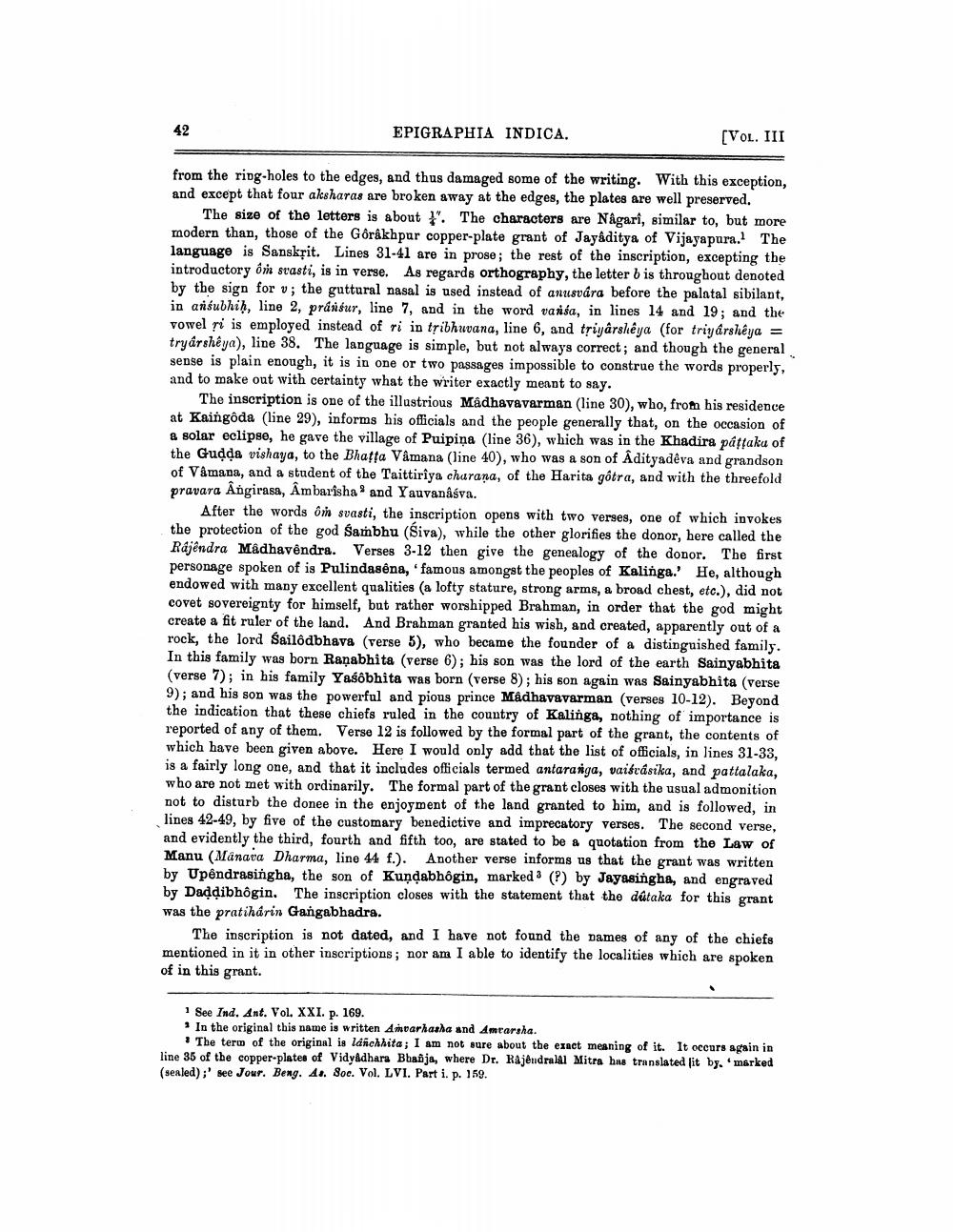________________
42
EPIGRAPHIA INDICA.
(VOL. III
from the ring-holes to the edges, and thus damaged some of the writing. With this exception, and except that four aksharas are broken away at the edges, the plates are well preserved.
The size of the letters is about *". The characters are Nagari, similar to, but more modern than, those of the Gôrakhpur copper-plate grant of Jayaditya of Vijayapura. The language is Sanskrit. Lines 31-41 are in prose; the rest of the inscription, excepting the introductory ôm svasti, is in verse. As regards orthography, the letter b is throughout denoted by the sign for v; the guttural nasal is used instead of anusvára before the palatal sibilant, in anśubhiḥ, line 2, prántur, line 7, and in the word varsa, in lines 14 and 19; and the vowel ri is employed instead of ri in tribhuvana, line 6, and triyårsheya (for triyårsheya = tryársheya), line 38. The language is simple, but not always correct; and though the general sense is plain enough, it is in one or two passages impossible to construe the words properly, and to make out with certainty what the writer exactly meant to say.
The inscription is one of the illustrious Madhavavarman (line 30), who, from his residence at Kaingôda (line 29), informs his officials and the people generally that, on the occasion of & solar eclipse, he gave the village of Puipiņa (line 36), which was in the Khadira páttaku of the Gudda vishaya, to the Bhatta Vâmana (line 40), who was a son of Adityadêva and grandson of Vamana, and a student of the Taittiriya charana, of the Harita gôtra, and with the threefold pravara Angirasa, Ambarisha and Yauvanaśva.
After the words om svasti, the inscription opens with two verses, one of which invokes the protection of the god Sambhu (Siva), while the other glorifies the donor, here called the Rajendra Madhavêndra. Verses 3-12 then give the genealogy of the donor. The first personage spoken of is Pulindasena, 'famous amongst the peoples of Kalinga.' He, although endowed with many excellent qualities (a lofty stature, strong arms, a broad chest, etc.), did not covet sovereignty for himself, but rather worshipped Brahman, in order that the god might create a fit ruler of the land. And Brahman granted his wish, and created, apparently out of a rock, the lord Sailôdbhava (verse 5), who became the founder of a distinguished family. In this family was born Ranabhita (verse 6); his son was the lord of the earth Sainyabhita (verse 7); in his family Yaśôbhita was born (verse 8); his son again was Sainyabhita (verse 9); and his son was the powerful and pious prince Madhavavarman (verses 10-12). Beyond the indication that these chiefs ruled in the country of Kalinga, nothing of importance is reported of any of them. Verse 12 is followed by the formal part of the grant, the contents of which have been given above. Here I would only add that the list of officials, in lines 31-33, is a fairly long one, and that it includes officials termed antaranga, vaisrásika, and pattalaka, who are not met with ordinarily. The formal part of the grant closes with the usual admonition not to disturb the donee in the enjoyment of the land granted to him, and is followed, in lines 42-49, by five of the customary benedictive and imprecatory verses. The second verse, and evidently the third, fourth and fifth too, are stated to be & quotation from the Law of Manu (Manava Dharma, line 44 f.). Another verse informs us that the grant was written by Upendrasingha, the son of Kundabhôgin, marked (?) by Jayasingha, and engraved by Daddibhôgin. The inscription closes with the statement that the dútaka for this grant was the pratihárin Gangabhadra.
The inscription is not dated, and I have not found the names of any of the chiefs mentioned in it in other inscriptions; nor am I able to identify the localities which are spoken of in this grant.
See Ind. Ant. Vol. XXI. p. 169. • In the original this name is written Antarhasha and Amrarsha.
The term of the original is lanchhita; I am not sure about the exact meaning of it. It occurs again in line 35 of the copper-plates of Vidyadhara Bhaja, where Dr. Rajendrall Mitra has translated sit by.marked (sealed); see Jour. Beng. 4.. Soc. Vol. LVI. Part i. p. 159.




